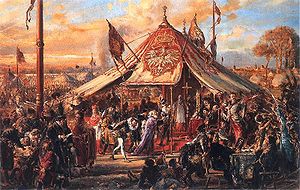
Polish Golden Age
Encyclopedia

Jagiellon dynasty
The Jagiellonian dynasty was a royal dynasty originating from the Lithuanian House of Gediminas dynasty that reigned in Central European countries between the 14th and 16th century...
, Sigismund August in 1569, or mid-17th century, when in 1648 the Polish-Lithuanian Commonwealth
Polish-Lithuanian Commonwealth
The Polish–Lithuanian Commonwealth was a dualistic state of Poland and Lithuania ruled by a common monarch. It was the largest and one of the most populous countries of 16th- and 17th‑century Europe with some and a multi-ethnic population of 11 million at its peak in the early 17th century...
was ravaged by the Khmelnytsky Uprising
Khmelnytsky Uprising
The Khmelnytsky Uprising, was a Cossack rebellion in the Ukraine between the years 1648–1657 which turned into a Ukrainian war of liberation from Poland...
and The Deluge
The Deluge (Polish history)
The term Deluge denotes a series of mid-17th century campaigns in the Polish–Lithuanian Commonwealth. In a wider sense it applies to the period between the Khmelnytsky Uprising of 1648 and the Truce of Andrusovo in 1667, thus comprising the Polish–Lithuanian theaters of the Russo-Polish and...
and the Golden Age ended.
During its Golden Age, Poland became the largest kingdom of Europe, stretching from the Baltic Sea and modern-day Estonia to the Black Sea and Moldavia. Polish armies were able to defeat numerous Turkish, Swedish, Russian, Prussian, Austrian and Mongol invasions and the country prospered thanks to its enormous grain, wood and salt exports.

